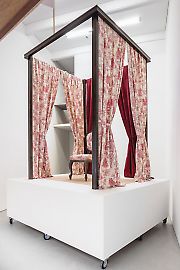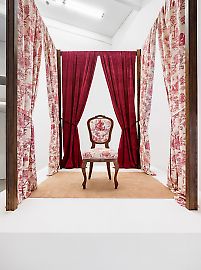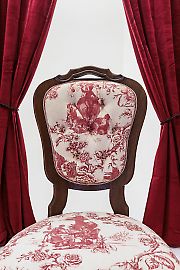Renée Green -- Commemorative Toile
For the exhibition Commemorative Toile at Galerie Metropol in 1993, Renée Green showed a number of works that she started to develop in Nantes, a major slave port in the eighteenth century. She started to investigate the production of Toile, a cotton fabric decorated with pastoral and historical scenes usually printed in a single colour using a copper plate. She found out that toile was widely produced during the 18th century in the vicinity of Nantes, among other locations. The fabric was used as a trading commodity in the Atlantic Trade and provided the wealth upon which the city of Nantes was built. Toile itself had an interesting history. At one time it was legally prohibited in France, as its popularity had reduced the economic might of the silk trade. Green began to investigate the motifs that were printed on several of these fabrics. In the residence where she was staying, an old chateau, she found a sofa upholstered in toile depicting scenes of George Washington and Native Americans. The specific fabric was referred to as “Indian”. When she returned to the United States, she began to produce it herself. In 1992, while in residence at the Fabric Workshop and Museum in Philadelphia, inspired by similar prints she had seen in France she created her own pattern for both fabric and wallpaper based on a locally sourced floral motif featuring various romanticised heterosexual couples. To craft her silk screen designs, Green took advantage of the very logic and history of toile production itself: thanks to the proliferation of European engraving technologies, eighteenth-century French artisans were able to mix, match, and recombine images from various sources in constructing novel patterns for their fabrics. The silkscreen process allows an even greater range and number of combinations due to its reliance on techniques of photomechanical reproduction. The artist selected images with quite a different tone that made visible the black presence haunting the cloth’s history. The image of a black nun is from the novel Ourika by Claire Duras published in 1823, a novel that explores themes of racial identity and societal expectations in 19th-century France. It tells the story of a young black woman named Ourika who is brought to France, raised in aristocratic circles, but grapples with her racial awareness and inner turmoil, ultimately seeking solace in a convent.
Additional illustrations include a depiction of a black Venus gracefully emerging from a shell, encircled by playful cherubs. Another image portrays a scene from the Haitian Revolution, showing a Frenchman's fate as he hangs from a Haitian hand. An engraving alluding to the "Code Noir," a French law issued in 1685 to establish the framework of slavery in the French colonial empire. In sixty articles, this decree limited the freedom of action of slaves, required the exclusive practice of Roman Catholicism and banned Jewish people from the colonies. This served to emphasise the sovereignty of France and to secure the lucrative business of the cruel sugar plantation economy. A revised version was enacted in 1724 and also recognised in Louisiana. The „Code Noir“ condemned slaves to legal and political invisibility to enforce obedience and prevent insurrection. Although efforts existed to protect slaves, they were rarely enforced consistently and lawbreaking colonial masters often went unpunished.
Green’s study led to the creation of multimedia installations incorporating textiles, furniture, videos, music, models, and fabrics. These installations took on diverse forms across multiple locations worldwide, often evoking the familiar ambiance of a salon or a museum dedicated to decorative arts. In his article Renée Green’s diasporic imagination (2013) Huey Copeland describes the installation at Metropol Gallery as its most expansive iteration describing it as follows:
“In the first room of the installation, which looked onto the street through four large plate glass windows, the artist included drapery, wallpaper, and furniture to make it seem like a decorative arts display, antiques showroom, or formal sitting area complete with “chorical” music by Händel, Schönberg, and Mozart, whose portrait hung on the wall. The second area was more akin to a domestic interior with a TV showing Green’s video of one of her trips to Cleveland and with a soundtrack provided by the contemporary band Siouxsie and the Banshees. The second room was accessible through the first not only in terms of its spatial connection but also through visual means: the far-left storefront window revealed a chair against a toile backdrop framed by curtains through which one could see- via another circular hole - the video playing in the second room. In addition, the communicating passageways between rooms were decorated with a series of framed sections of the fabric.“
Cathrin Mayer (2023)





